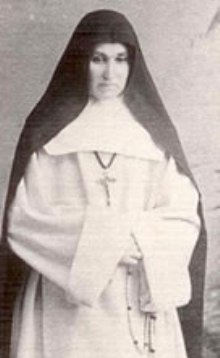Marie-Renee Roudaut was born on March 3, 1847, in Guissény, Brittany, France into a farm family. She was the sixth child in the family.
When she was a child, the archbishop of Algeria, Charles Lavigerie, founded a religious order of priests and brothers, Missionaries of Our Lady of Africa, to work in the nations of Africa. The men of the order were often called the White Fathers because of their white habit. Later, he founded a companion order of religious women to run diocesan orphanages.
It was in that order that a cousin of Marie-Renee joined. Unfortunately, however, she had to leave the order because of poor health. When the cousin returned to France, she told exciting stories of mission life to Marie-Renee. Marie-Renee was so impressed with these missionary tales, that at the age of 24, she left France in October 1871 to join the order as a postulant.
On January 26, 1871, Marie-Renee was assigned to serve in the orphanage of St. Charles in the Algiers suburb of Kouba, Algeria. On June 23,1872, Marie-Renee received the white habit of her order and became known as Sister Marie-Salome. She made her first profession on July 6,1873.
In January of 1874, Sister Marie-Salome served in the mission of St. Cyprien of the Attafs, a village for orphans the church had raised and where now adults. Later, she served in a new mission at Ouadhias, Kabylia. In October 1879, Sr. Marie-Salome was elected Assistant General of the order, and a year later, she became head of the novitiate.
On September 14, 2882, the sisters elected Marie-Salome as their Superior General at their third general chapter. At that time, their order was named the “Teaching & Hospitaller Sisters of Our Lady of the Missions of Africa,” and the sisters adopted rules like those of the White Fathers.
On April 6, 1885, however, Charles Lavigerie, now a cardinal, dissolved the sisters’ congregation. He did this because he thought many of the sisters lacked a solid education foundation and were not qualified for missionary work. He also noted that they lacked money, had difficulty obtaining equipment, and there was a scandal when one of the sisters defected from the order.
Mother Salome, backed by the other sisters, convinced Cardinal Lavigerie to reverse his decision. On February 9, 1886, the motherhouse and novitiate returned to St. Charles. In September of 1886, Mother Salome was reelected Superior General of the order.
In 1887, Mother Salome opened new postulates in Lyon, France and Maastricht, Netherlands, and in November of the same year, she moved the motherhouse to Carthage, Tunisia. In 1888, the sisters received a decree of praise for the congregation that became known as the “Missionary Sisters of Our Lady of Missions of Africa.” On December 13, 1893, the Sacred Congregation of Propaganda Fide gave the order autonomy; the superior general would have full authority for governing the order.
With Mother Salome’s leadership, the congregation grew. The sisters were found running healthcare clinics, schools, and adult education programs for homemakers. In time, the order expanded to Sudan.
Mother Salome continued to be reelected superior general through the years, but by 1917, she was no longer able to travel. On June 28, 1925, Mother Salome resigned as superior general, and she died at St. Charles, Algeria, on October 18, 1930, at the age of 83. Today, the order, known officially as the Missionary Sisters of Our Lady of Africa, continue serving various nations of Africa.



